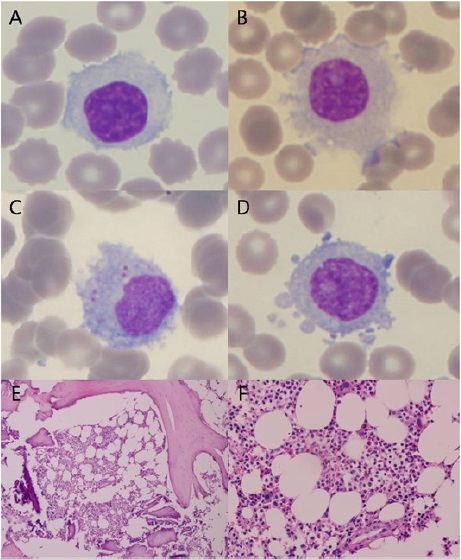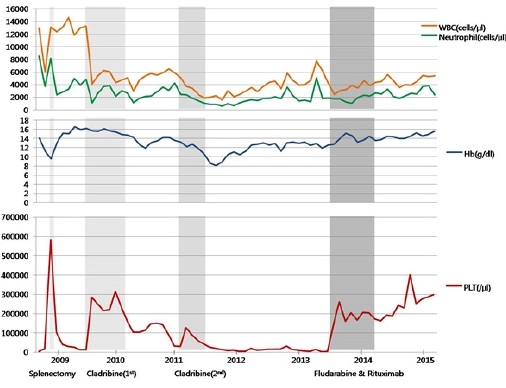Kosin Med J.
2018 Dec;33(3):438-445. 10.7180/kmj.2018.33.3.438.
Fludarabine and Rituximab in Relapsed or Refractory Hairy Cell Leukmia Variant: A Case Report and Review of Literature
- Affiliations
-
- 1Departments of Internal medicine, Laboratory medicine, Veterans Health Service Medical Center, Seoul, Korea. mednsh@hanmail.net
- 2Departments of Laboratory medicine, Veterans Health Service Medical Center, Seoul, Korea.
- KMID: 2442557
- DOI: http://doi.org/10.7180/kmj.2018.33.3.438
Abstract
- Hairy cell leukemia (HCL) is a rare chronic B cell leukemia morphologically characterized by cells with an abundant cytoplasm and hair-like projections that can be found in the peripheral blood and bone marrow. The treatment for HCL is splenectomy or chemotherapy with the purine analogs pentostatin and cladribine. However, patients continue to relapse. Retreatment with the same or alternate purine analogs produces lower response rates and a shorter duration of response. Fludarabine is another purine analog widely used in treating indolent lymphoid cancers, often in combination with rituximab. Here, we report a case of HCL variant in a 60-year-old man who experienced multiple relapses after splenectomy and retreatment with cladribine. The patient was then treated with fludarabine and rituximab combination chemotherapy. After the treatment, he achieved complete remission that continued for 35 months.
Keyword
MeSH Terms
Figure
Reference
-
1. Gerrie AS, Zypchen LN, Connors JM. Fludarabine and rituximab for relapsed or refractory hairy cell leukemia. Blood. 2012; 119:1988–1991.
Article2. Else M, Dearden CE, Matutes E, Garcia-Talavera J, Rohatiner AZ, Johnson SA, et al. Long-term follow-up of 233 patients with hairy cell leukaemia, treated initially with pentostatin or cladribine, at a median of 16 years from diagnosis. Br J Haematol. 2009; 145:733–740.
Article3. Sgarabotto D, Vianello F, Radossi P, Poletti A, Sotti G, Stefani PM, et al. Remission in hairy cell leukemia-variant following splenic radiotherapy alone. Leuk Lymphoma. 1997; 26:395–398.
Article4. Golomb HM, Vardiman JW. Response to splenectomy in 65 patients with hairy cell leukemia: an evaluation of spleen weight and bone marrow involvement. Blood. 1983; 61:349–352.
Article5. Magee MJ, McKenzie S, Filippa DA, Arlin ZA, Gee TS, Clarkson BD. Hairy cell leukemia. Durability of response to splenectomy in 26 patients and treatment of relapse with androgens in six patients. Cancer. 1985; 56:2557–2562.
Article6. Habermann TM, Rai K. Historical treatments of in hairy cell leukemia, splenectomy and interferon: past and current uses. Leuk Lymphoma. 2011; 52:18–20.
Article7. Maevis V, Mey U, Schmidt-Wolf G, Schmidt-Wolf IG. Hairy cell leukemia: short review, today's recommendations and outlook. Blood Cancer J. 2014; 4:e184.
Article8. Robak T. Current treatment options in hairy cell leukemia and hairy cell leukemia variant. Cancer Treat Rev. 2006; 32:365–376.
Article9. Johnston JB. Mechanism of action of pentostatin and cladribine in hairy cell leukemia. Leuk Lymphoma. 2011; 52:43–45.
Article10. Almasri NM, Duque RE, Iturraspe J, Everett E, Braylan RC. Reduced expression of CD20 antigen as a characteristic marker for chronic lymphocytic leukemia. Am J Hematol. 1992; 40:259–263.
Article11. Robbins BA, Ellison DJ, Spinosa JC, Carey CA, Lukes RJ, Poppema S, et al. Diagnostic application of two-color flow cytometry in 161 cases of hairy cell leukemia. Blood. 1993; 82:1277–1287.
Article12. Reff ME, Carner K, Chambers KS, Chinn PC, Leonard JE, Raab R, et al. Depletion of B cells in vivo by a chimeric mouse human monoclonal antibody to CD20. Blood. 1994; 83:435–445.
Article13. Kreitman RJ, Arons E, Stetler-Stevenson M, Fitzgerald DJ, Wilson WH, Pastan I. Recombinant immunotoxins and other therapies for relapsed/ refractory hairy cell leukemia. Leuk Lymphoma. 2011; 52:82–86.
Article14. Jones G, Parry-Jones N, Wilkins B, Else M, Catovsky D. British Committee for Standards in Haematology. Revised guidelines for the diagnosis and management of hairy cell leukaemia and hairy cell leukaemia variant*. Br J Haematol. 2012; 156:186–195.
Article15. Malfuson JV, Fagot T, Konopacki J, Souleau B, Cremades S, de Revel T. Which role for rituximab in hairy cell leukemia? Reflections on six cases. Acta Haematol. 2010; 123:110–116.
Article16. Else M, Dearden CE, Matutes E, Forconi F, Lauria F, Ahmad H, et al. Rituximab with pentostatin or cladribine: an effective combination treatment for hairy cell leukemia after disease recurrence. Leuk Lymphoma. 2011; 52:75–78.
Article17. Lauria F, Forconi F. Combination therapies to improve the long-term outcome in hairy cell leukemia. Leuk Lymphoma. 2009; 50:Suppl 1. 18–22.
Article18. Forconi F. Hairy cell leukaemia: biological and clinical overview from immunogenetic insights. Hematol Oncol. 2011; 29:55–66.
Article
- Full Text Links
- Actions
-
Cited
- CITED
-
- Close
- Share
- Similar articles
-
- Remission after Rituximab Therapy in Refractory Myasthenia Gravis
- A Case of Hairy Cell Leukemia, Variant
- Radioimmunotherapy with 131I-Rituximab in a Patient with Diffuse Large B-Cell Lymphoma Relapsed After Treatment with 90Y-Ibritumomab Tiuxetan
- Novel combination immunochemotherapy beyond CD20 for B-cell lymphomas
- Rituximab and ESHAP as Second-line Therapy for Relapsed or Primary Refractory Diffuse Large B Cell Lymphoma: The Experience of a Single Center in Korea



